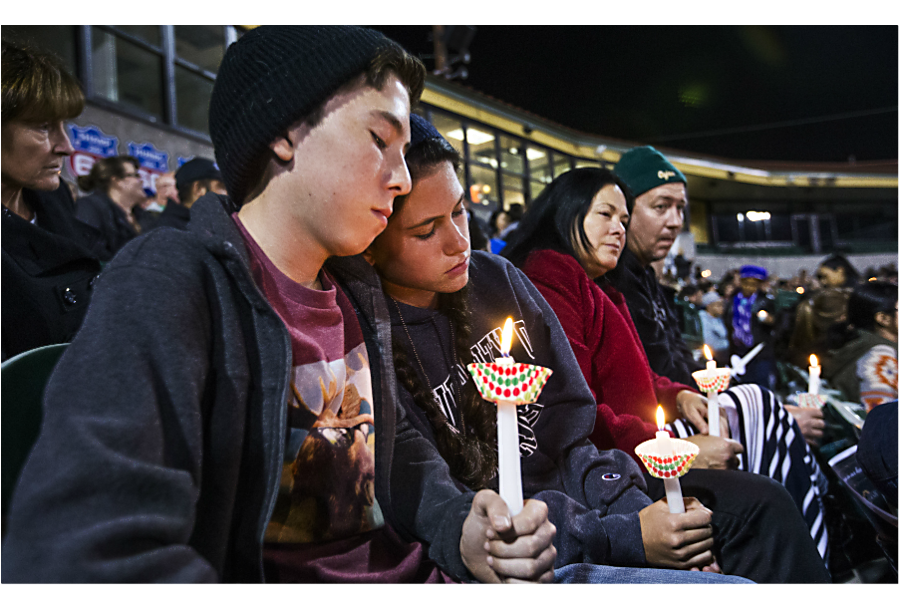In San Bernardino, long hit by hard times, determination for a better future
Loading...
| San Bernardino, Calif.
They came from all over southern California’s Inland Empire Thursday night, filling the baseball stadium in San Bernardino: mothers and sons, professors and professionals, construction workers and even video-game teammates – all of them here to show that while the city may be down after Wednesday’s shootings, it is not out.
“We’ve been having hard times here,” said Lisa Mosqueda, a mother of seven who has lived in this city of some 210,000 her entire life. “But I think this is our time to turn a corner, to show the world we can do something better, that we don’t have to have violence and crime like this anymore.”
Hardship is not new in this city some 65 miles east of Los Angeles, still in the throes of a 3-year-old bankruptcy filing. It is the second-largest California city to go bankrupt, and between 2009 and 2013, 32 percent of its residents lived in poverty, according to US Census data.
A June profile in the Los Angeles Times noted that this city, once a solid middle-class community, is now the poorest of its size in the nation and a symbol of America’s worst urban woes.
And yet, hope in the face of despair, resilience in the presence of hard knocks – these are persistent themes in San Bernardino, which, immediately after the rampage, a local columnist dubbed “a scrappy city.”
“Definitely a scrappy place,” said Adam Murvine, who owns a small construction company. “This whole area has been hard hit by economic times, but it is bouncing back better than could be expected.”
Mr. Murvine came to the vigil along with a slew of fellow video-game enthusiasts to honor Daniel Kaufman, one of the 14 victims of Wednesday’s massacre, which the FBI is investigating as terrorism. Mr. Kaufman was part of an online multi-player video game called Ingress.
“All of us in the Inland Empire, we’re family and when one of us is hurt, we all hurt,” said Murvine, as fellow players at his side nodded agreement. “But this will bring us together” – moments like this that “show the world what we are made of, who we are as human beings,” he said.
“I will never forget the hug Daniel gave me the first time we met [off-line],” said Murvine. “We played a silly video game together, but I am a better person for knowing him.”
Some who have been working hard to help San Bernardino turn a corner hope the national spotlight will help.
“We don’t need any more speeches,” said Oskar Zambrano, a community organizer for the region. “We’ve been fighting the issue of violence and crime for years in San Bernardino,” he said, standing outside the stadium. “Now we are coming together to say these are issues we live with every day and it’s time to take action to get some resources into the city.”
Inside the stadium, the walls brimmed with rebuffs to despair. “SB Strong” shone from digital displays alongside the city seal, which reminded the crowd that this city has roots, having been founded in 1810. Those roots have power, says local daughter Monica Lagos, who left a “good job” in Los Angeles four years ago to “come home.”
Ms. Lagos, who now works at City Hall, says San Bernardino is finally on the upswing and residents will not let this moment change that. She pointed to the imminent arrival of JCPenney as the anchor store to a local mall next year as evidence of a turnaround, adding, “The lease has been signed.”
A crowd of more than 3,000, three fourths holding lit candles, sat quietly wearing beak caps, snowball hats, hoodies, and bomber jackets. The loudspeakers carried songs ranging from "Stand by Me" to "In the Arms of an Angel." Then five local youths sang "The Prayer" and other songs befitting the occasion – with soaring a cappella harmonies.
Pastors eulogized and inspired while politicians spoke of determination to fight back. But it was the heart and community spirit of the people that shone through for Juan Carlos Belliard, a professor of public health.
“I work here,” he said, pointing to a flag fluttering atop a nearby building. “San Bernardino has been dealt a lot of hard blows recently,” he said, “and a lot of the publicity this city has received has been negative. But I see that despite all the barriers ... they are fighting to make a change and build a better life for their children.”
His wife, Stacey, added, “This gathering means people here have already shown such resiliency but also determination to overcome hardships. And this awful event is an opportunity for them to show the nation how to come together instead of letting something like this divide them.”





